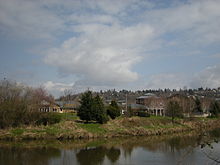PTE 기술
PTE technique광열전성(PTE) 효과는 열전성(TE) 물질에 빛을 흡수하여 가열하는 시벡 효과를 기반으로 합니다.재료의 열 특성화를 위한 PPE 기술과 동일하게 PTE는 열전기(센서 및 샘플 역할)와 기타 샘플 재료(센서 [1]역할)를 모두 열 특성화하는 데 사용할 수 있습니다.이러한 센서의 장점은 파이로 물질이 퀴리 온도로 제한되기 때문에 적용 가능한 온도 범위가 넓기 때문입니다.반면에, TE 재료로부터 유용한 신호를 얻기 위해서는 Seebeck 계수에 따라 상대적으로 많은 양의 열(빛 들뜸)이 재료에 축적되어야 합니다.지금까지, 주파수 영역 PTE 기술은 재료의 열 특성화를 위한 예비 단계에 있습니다.액체 열전기 분야에서도 [2]PTE에 대한 발전이 이루어졌습니다.[3]
레퍼런스
- ^ Kuriakose, Maju; Depriester, Michael; Chan Yu King, Roch; Roussel, Frédérick; Hadj Sahraoui, Abdelhak (2013). "Photothermoelectric effect as a means for thermal characterization of nanocomposites based on intrinsically conducting polymers and carbon nanotubes". Journal of Applied Physics. 113 (4): 044502–044502–6. Bibcode:2013JAP...113d4502K. doi:10.1063/1.4788674. ISSN 0021-8979.
- ^ Dadarlat, D.; Tripon, C. (2019-06-01). "The photothermoelectric effect of liquid thermoelectrics as a tool for the detection of ferro–paraelectric phase transitions in solids". Journal of Thermal Analysis and Calorimetry. 136 (5): 2165–2170. doi:10.1007/s10973-018-7887-2. ISSN 1588-2926.
- ^ Touati, Karim; Depriester, Michael; Guilmeau, Emmanuel; Sotelo, Andrés; Madre, Maria A; Gascoin, Franck; Sahraoui, Abdelhak Hadj (2017-06-13). "General approach of the photothermoelectric technique for thermal characterization of solid thermoelectric materials". Journal of Physics D: Applied Physics. 50 (26): 265501. Bibcode:2017JPhD...50z5501T. doi:10.1088/1361-6463/aa748d. hdl:10261/181954. ISSN 0022-3727. S2CID 126387936.


